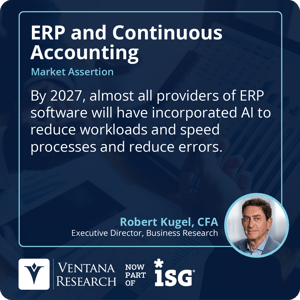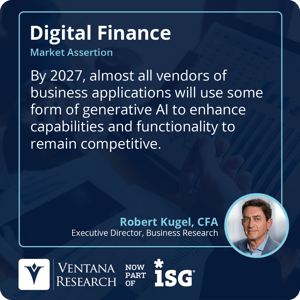Sage Intacct Enhances Its Roadmap for AI and Generative AI
Sage Intacct recently held its annual user conference, and while there were plenty of product announcements and roadmap presentations, my focus here is on the artificial intelligence elements. AI–both predictive and generative–is the most important capability and differentiator in software aimed at finance and accounting departments. Ventana Research asserts that by 2027, almost all vendors of ERP software will incorporate AI to reduce workloads, speed processes and decrease errors.
Sage and other ERP vendors are in a race to infuse AI capabilities into software as fully and rapidly as possible without frustrating users, while retaining a reputation for reliability. Picking winners and losers at this point is premature as it’s still early innings in assessing who’s ahead (an appropriate metaphor since Sage is now a Major League Baseball sponsor in the U.S.).
Picking winners and losers at this point is premature as it’s still early innings in assessing who’s ahead (an appropriate metaphor since Sage is now a Major League Baseball sponsor in the U.S.).
AI in its multiple forms will enhance midsize enterprises’ capabilities and competitiveness, leveling the playing field with large enterprises. Midsize enterprises (which ISG-Ventana Research defines as those with between 100 and 1,000 employees) have almost all the requirements as large ones but with fewer resources. Technology designed specifically for this market segment is narrowing the gap between these two segments by giving these enterprises a force multiplier that enhances productivity and effectiveness in ways that were not previously possible.
Sage highlighted its roadmap for bringing AI and generative AI to its product lines. I contend that, at this stage in the development of the technology, evaluations of a provider’s capabilities in applying AI to business software should focus on:
- Data management: All AI capabilities are data dependent, and all business software that makes AI claims must facilitate data management to reduce customers’ efforts in acquiring and maintaining data necessary to realize the benefits advertised.
- Integration: AI works as an adjunct to the core functionality of almost all business applications. Unlike past periods of disruption, category incumbents have an overwhelming advantage relative to start-ups because they already have the domain functionality. Moreover, they also have relationships and revenue from existing customers to fund AI investments.
- LLMs: For now, almost all software providers will source a variety of large language models from providers that can spread development costs across multiple customers.
- Development timing: Finance and accounting departments are risk-averse and technology laggards. Software providers, therefore, have every incentive to be conservative in pacing AI-enabled features. Trailing behind the most advanced by one or several quarters is far less of a negative than releasing code that undermines trust or frustrates users.
Sage also previewed its Copilot offering, expected with limited availability later this year. It’s a digital assistant designed to handle administrative and repetitive tasks, using workflows, error identification and predictive analytics to increase productivity. Copilots are virtual assistants that use natural language processing and large language models to help users perform a wide range of tasks. An increasingly common feature of business software, a copilot can answer questions, interpret complex conversations and summarize content. It can automate a wide range of common tasks and create new content, enabling individuals to be more productive.
These capabilities are evolving from familiar and relatively simple chatbots (Amazon’s Alexa came out in 2014) to today’s digital assistant that has a broader understanding of content and nuance and capable of undertaking more complex actions. Ventana Research asserts that by 2027, almost all vendors of business applications will use some form of generative AI to enhance capabilities and functionality to remain competitive.
and nuance and capable of undertaking more complex actions. Ventana Research asserts that by 2027, almost all vendors of business applications will use some form of generative AI to enhance capabilities and functionality to remain competitive.
Ultimately, I expect these sorts of copilots will become more sophisticated digital associates that, for example, would read and periodically provide the user with a summary of emails, offering suggestions for follow-ups such as drafting responses. If an out-of-town meeting was required, the associate would update the user’s calendar, cancel conflicting appointments and make travel arrangements that fully reflected the user’s specific preferences.
The true digital associate is still probably a few years away, but many valuable use cases are relatively easy to put into reliable service, such as helping to perform straightforward, repetitive daily tasks faster because there is limited variation in how the work is performed. And copilots can also shepherd an individual through a process used infrequently so that a worker doesn’t have to thrash around, trying to remember how to handle that task. Consequently, a copilot can also reduce the time required to onboard and train new staff.
More complex situations are either here or within easy reach. For example, Sage demonstrated a scenario where the system flagged a large invoice that had not been accepted by a customer, notified the appropriate individual and asked if it should reach out to the customer. Instructed to do so, the system drafted a full email for review.
The underlying technology for a digital assistant makes a difference. General-purpose large language models are fine for common interactions, but as processes and their subject matter become more specific, they require domain-specific LLMs to improve accuracy and trust. Sage is working with Amazon Web Services, using Bedrock and Lex LLMs to create an accounting- and finance-specific LLM. Specificity counts with generative AI, so to achieve the reliability and speed necessary for hands-free operation, Sage and other developers are using cocktails of narrow, small and midsize LMs to execute operations. For example, the company noted that off-the-shelf optical character recognition technology has limitations, which must be augmented by 24 special-purpose machine learning models for reading and properly coding invoice data. It stated that it has achieved full accuracy for 68% of the invoices processed, which is a good start.
I am still of the belief that a core strategic strength of the company is its Sage Network. The network automates and synchronizes financial transactions and processes between businesses, even those not using Sage accounting software. It provides Sage’s customers with valuable peer-to-peer capabilities such as e-invoicing, accounts payable automation and payment processing.
A network can facilitate supplier/buyer relationships through streamlined onboarding, logistics, transaction processing and the sharing of end-to-end electronic documentation from purchase order to payment advice, significantly reducing the frictions caused by manual processes and the inevitable errors and delays that go along with them. Members of the network can communicate with each other electronically in a secure environment, eliminating the need for paper and further reducing frictions in transactions. Applying AI to these electronic communications also makes it possible to automatically match purchase orders to invoices at the line level while noting all discrepancies in volume, cost or additional or missing items.
AI enhances the value of the network and vice versa since the aggregation of that much data can accelerate the ability of machine learning algorithms to perform a broad set of useful tasks accurately. A network also “sees” a lot of data, documents and other digital objects, each with its own set of characteristics. These digital fingerprints are useful for many purposes, including flagging duplicative or potentially fraudulent billing or assessing the urgency or importance of issues. Because the system sees more types of invoices from a broader set of suppliers than a single enterprise, it improves the ability of customers to scan invoices accurately by drawing on the “learning” performed by all members of the network. Similarly, by applying multiple narrow language models to text contained in the invoice, Sage’s systems can enrich the data with its accounting significance and claims to achieve near-complete first-pass accuracy on scanned invoices.
Sage continues to add application programming interfaces to connect ERP systems. The ability to broadly link processes and data to serve the needs of individual customers and potentially non-Sage accounting customers will result in a significant gain in the business performance of SMBs to close the technology gap between midsize and larger establishments. The network also reduces the reliance of midsize organizations on spreadsheets, which are excellent tools for personal productivity but aren’t well suited to support an organization’s business processes.
On product news, Sage showed off an enhanced version of its business planning software, making the user experience more approachable to those participating in the process. The software provides for multi-year budgeting, meaning it supports rolling budgets and forecasts and can be used for longer-range planning. It is specifically designed for use by nonprofits, one of Sage Intacct’s core verticals. Like education and governments, nonprofits must have the ability for funds accounting because money from grants and other forms of restricted funding cannot be commingled with general-purpose, unrestricted funds.
The software provider also demonstrated further progress in building out its Sage Intacct Construction, one of three applications designed for this industry, which historically has underinvested in technology. AI and AI-related services for the construction vertical have significant potential because project contracting, costing, bidding and billing are highly labor-intensive and imprecise. And it showed further expansion in its manufacturing offering, although this is still a work in progress.
Midsize enterprises can gain substantial productivity from today’s ERP systems, especially those transitioning from an entry-level system or moving from an on-premises application to the cloud. For those considering new software, I strongly recommend researching what’s possible today that might not have been possible the last time such a purchase was considered. And I recommend including Sage Intacct as part of the assessment process.
Regards,
Robert Kugel
Authors:

Robert Kugel
Executive Director, Business Research
Robert Kugel leads business software research for Ventana Research, now part of ISG. His team covers technology and applications spanning front- and back-office enterprise functions, and he personally runs the Office of Finance area of expertise. Rob is a CFA charter holder and a published author and thought leader on integrated business planning (IBP).










